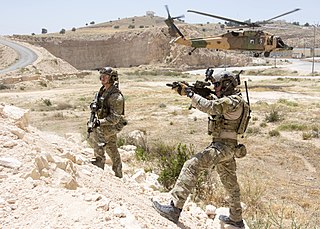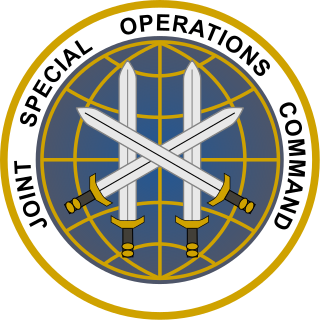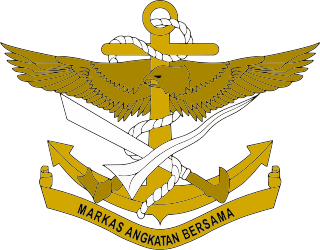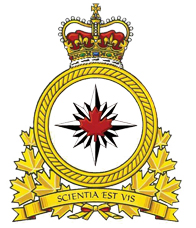
The Finnish Defence Forces (FDF) (Finnish: Puolustusvoimat, Swedish: Försvarsmakten) are the military of Finland. The Finnish Defence Forces consist of the Finnish Army, the Finnish Navy, and the Finnish Air Force. In wartime, the Finnish Border Guard becomes part of the Finnish Defence Forces.

The Australian Defence Force (ADF) is the military organisation responsible for the defence of the Commonwealth of Australia and its national interests. It has three branches: the Royal Australian Navy (RAN), Australian Army and the Royal Australian Air Force (RAAF). The ADF has a strength of just over 89,000 personnel and is supported by the Department of Defence and several other civilian agencies.

The Canadian Armed Forces are the unified military forces of Canada, including land, sea, and air commands referred to as the Canadian Army, Royal Canadian Navy, and the Royal Canadian Air Force. The CAF also operates several other commands, including the Canadian Forces Intelligence Command, the Canadian Joint Operations Command, and the Canadian Special Operations Forces Command. Personnel may belong to either the Regular Force or the Reserve Force, which has four sub-components: the Primary Reserve, Supplementary Reserve, Cadet Organizations Administration and Training Service, and the Canadian Rangers. Under the National Defence Act, the Canadian Armed Forces are an entity separate and distinct from the Department of National Defence, which also exists as the civilian support system for the forces.

Special operations or special ops are military activities conducted, according to NATO, by "specially designated, organized, selected, trained, and equipped forces using unconventional techniques and modes of employment." Special operations may include reconnaissance, unconventional warfare, and counterterrorism, and are typically conducted by small groups of highly trained personnel, emphasizing sufficiency, stealth, speed, and tactical coordination, commonly known as special forces.

Joint Task Force 2 is Canada's Tier 1 special operations force mandated with protecting Canadian national interests and combating terrorism threats both domestic and abroad. JTF 2 serves under the Canadian Special Operations Forces Command of the Canadian Armed Forces and is typically compared to American Delta Force and SEAL Team Six, the British Special Air Service, the Australian Special Air Service Regiment and 2nd Commando Regiment, and the New Zealand Special Air Service. Most information concerning JTF 2 is classified and is not usually commented on by the Canadian Armed Forces or the Government of Canada.

The Norwegian Armed Forces is the military organization responsible for the defence of Norway. It consists of five branches, the Norwegian Army, the Royal Norwegian Navy, which includes the Coast Guard, the Royal Norwegian Air Force, the Home Guard, and Norwegian Cyber Defence Force as well as several joint departments.

The Singapore Armed Forces (SAF) are the military of the Republic of Singapore, responsible for protecting and defending the security interests and the sovereignty of the country. A component of the Ministry of Defence (MINDEF), the armed forces have four service branches: the Army, Navy, Air Force, and Digital and Intelligence Service. An integrated force, it is one of the most capable, robust, technologically sophisticated and powerful militaries in the Southeast Asia region. The SAF is headed by the chief of defence force, appointed by the President, on the advice of the Cabinet.

The Royal Canadian Air Force is the air and space force of Canada. Its role is to "provide the Canadian Forces with relevant, responsive and effective airpower". The RCAF is one of three environmental commands within the unified Canadian Armed Forces. As of 2020, the Royal Canadian Air Force consists of 12,074 Regular Force and 1,969 Primary Reserve personnel, supported by 1,518 civilians, and operates 258 manned aircraft and nine unmanned aerial vehicles. Lieutenant-General Eric Kenny is the current Commander of the Royal Canadian Air Force and Chief of the Air Force Staff.

The Singapore Army is the land service branch of the Singapore Armed Forces (SAF). The largest of the four branches of the SAF, the Singapore Army traces its origins to the 1st Battalion, Singapore Infantry Regiment, which was formed in 1957, when Singapore was still under British colonial rule. After Singapore's independence on 9 August 1965, the Singapore Army Bill was passed in Parliament on 23 December 1965, and National Service (NS) was subsequently introduced in 1967. Mostly made up of conscripts, the Singapore Army can mobilise all operationally-ready military reservists in the event of war or national exigencies.

A military staff or general staff is a group of officers, enlisted and civilian staff who serve the commander of a division or other large military unit in their command and control role through planning, analysis, and information gathering, as well as by relaying, coordinating, and supervising the execution of their plans and orders, especially in case of multiple simultaneous and rapidly changing complex operations. They are organised into functional groups such as administration, logistics, operations, intelligence, training, etc. They provide multi-directional flow of information between a commanding officer, subordinate military units and other stakeholders. A centralised general staff results in tighter top-down control but requires larger staff at headquarters (HQ) and reduces accuracy of orientation of field operations, whereas a decentralised general staff results in enhanced situational focus, personal initiative, speed of localised action, OODA loop, and improved accuracy of orientation.

The Canadian Forces Military Police provide police, security and operational support services to the Canadian Armed Forces (CAF) and the Department of National Defence (DND) worldwide.

The Canadian Forces National Investigation Service (CFNIS) is the investigative arm of the Canadian Forces Military Police. The CFNIS is an independent military police unit that provides an independent investigative capability for the purpose of fair and impartial administration of military justice.

Canadian Forces Base Trenton, formerly RCAF Station Trenton, is a Canadian Forces base located within the city of Quinte West, Ontario. It is operated as an air force base by the Royal Canadian Air Force (RCAF) and is the hub for air transport operations in Canada and abroad. Its primary RCAF lodger unit is 8 Wing, commonly referred to as 8 Wing Trenton. CFB Trenton is Canada's largest Air Force base and most southerly air base.

The Joint Special Operations Command (JSOC) is a joint component command of the United States Special Operations Command (USSOCOM) and is charged with studying special operations requirements and techniques to ensure interoperability and equipment standardization, to plan and conduct special operations exercises and training, to develop joint special operations tactics, and to execute special operations missions worldwide. It was established in 1980 on recommendation of Colonel Charlie Beckwith, in the aftermath of the failure of Operation Eagle Claw. It is headquartered at Pope Field.

39 Canadian Brigade Group is a Canadian Forces formation of the Canadian Army under the 3rd Canadian Division. The brigade group is composed of Canadian Forces (CF) Primary Reserve units, all of which are based within the province of British Columbia. 39 CBG Headquarters is located at the Major-General B.M. Hoffmeister OC, CB, CBE, DSO Building, 1755 West 1st Avenue, Vancouver.

The Joint Forces Headquarters is a joint military command which specifically formed to command all tasks of the Malaysian Armed Forces joint operations. The Joint Operations are other operations performed by at least three services such as Malaysian Army, Royal Malaysian Navy and the Royal Malaysian Air Force.

Combined Joint Task Force – Operation Inherent Resolve (CJTF–OIR) is a multinational military formation established by the U.S.-led international coalition against the Islamic State with the stated aim to "degrade and destroy" the organization. Led by United States Army Central (ARCENT), it is composed of military forces and personnel from over 30 countries.

The Swedish Armed Forces Headquarters is the highest level of command in the Swedish Armed Forces. Established in 1994, its primary task is to command operations, but is also involved in areas such as military strategy, the overall development of the Swedish Armed Forces, and acting as a channel of contact with government. It's located at Lidingövägen 24 at Gärdet in Stockholm.

















